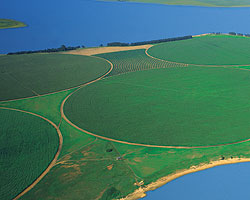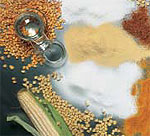| African Products |
|||||||
African Products, the continent's premier wet miller, converts almost 600 000 tons of maize each year into starch and its derivatives. Also derived from other sources including wheat, cassava and potato, starch is one of nature's most versatile raw materials. It finds application in virtually all spheres of contemporary living, be it foodstuffs, printing, packaging, construction, textiles, brewing, baking or pharmaceuticals. Starch's true potential has yet to be realised - a challenge African Products has embraced with enthusiasm. Placing a strong emphasis on new product development, we are currently engaged with a range of projects including the testing of starch as a depressant in the mining industry, as a component in plastic, and as part of technology to produce desiccants in packaging. African Products is also investigating alternative sources of starch and other agricultural products and will commission a guar modification plant in mid-2003. Also under consideration is capital expansion at Meyerton to add value to waxy modified starches. Pursuing a balanced strategy to serve the domestic and export markets,
African Products is poised to capitalise on opportunities to realise the
untapped potential of starch as a base material. Operational Review
African Products has ceased to account for its SAFEX maize purchasing activities as executory contracts and in compliance with AC 133 marks-to-market the value of its derivative instruments at the end of each accounting period. As a consequence, operating earnings for 2002 of R240 million have reduced by R20 million and restated operating earnings for 2001 have increased by R51 million. Local Market Developments African Products registered strong domestic growth of ten percent in 2002. This growth was driven by a number of factors, including new business initiatives, increased utilisation of products in some sectors, a growth in exports by African Products' customers, and import substitution prompted by the weak Rand which prevailed for most of the year. Growth was broad-based but the market sectors that performed particularly
well included confectionery, spray drying, canning, prepared foods, beer
brewing, paper An exceptionally busy seasonal peak in October and November placed pressure on production capacity which will be alleviated once grind capability at Kliprivier has been increased to 1 200 tons per day. A study to investigate African Products' glucose syrup production capabilities is also underway. Export Market Developments Following a period of relatively flat export growth from 1998 to 2000, African Products posted record exports in 2001 and the first half of 2002. Exports to unattractive markets were selectively reduced in the second half of 2002 as a result of the higher maize price and the strengthening of the Rand. This resulted in a drop in export volume from over 71 000 tons in 2001 to
64 000 tons in 2002. Export contribution rose by 24 percent due to an
improvement in the mix of exports and the relatively weak Rand compared to
the previous year.
International Trends in Starch and Glucose The trend among international starch producers is to explore opportunities that add value to starch through new product and application development and includes such applications as polymers for use in bio-degradable plastics. Major international players continued to develop the industry in the East, particularly in China and Thailand. Interest in cassava as a source of starch has continued to develop and Corn Products, African Products' technical partner, has just commissioned the world's largest cassava plant in Thailand. New Business Development African Products continues to develop its range of products and investigate new projects. In volume terms, value-added products grew by 17 percent in 2002. A number of projects have been initiated and will be commissioned early in 2003. These include a R10 million expansion to Germiston's dextrose monohydrate plant, an R18 million expansion to its maltodextrin spray tower, and the installation of a R10 million plant to modify guar flour into products for the mining industry. Extracted from the guar bean, the guar flour project represents a departure for African Products from the traditional raw material of maize. Plans are under consideration for further capital expansions at Meyerton to widen the range of waxy modified starches. A number of long-term projects are underway to investigate new uses for starch, together with projects to harness new production technologies for the manufacture of higher value products. Maize Market Trends The last few years have been characterised by high volatility in the South African maize market. During the planting season of 2001, African Products purchased significant quantities of maize, for use in 2002, at competitive prices, albeit still at levels 40 percent higher than the 2000/1 season. This unfortunately resulted in African Products having to implement significantly higher product prices for 2002. The price of maize rose sharply during the last quarter of the 2002 planting season, and African Products has contracted a large portion of its maize requirements for 2003/4 at prices higher than 2002. Although the price of maize has since declined, the overall impact of the price movement will result in a significant increase in maize costs. Outlook Local volumes are projected to show positive growth in 2003 and the drive on exports will be maintained. This will be supported by continued focus on new developments and higher value products. Initiatives are in place to reduce both variable and fixed costs. The stronger Rand and high maize price will put pressure on margins and
the mark-to-market accounting requirements of AC 133 is expected to further
impact African Products' results, particularly in the first half of the
year. |


